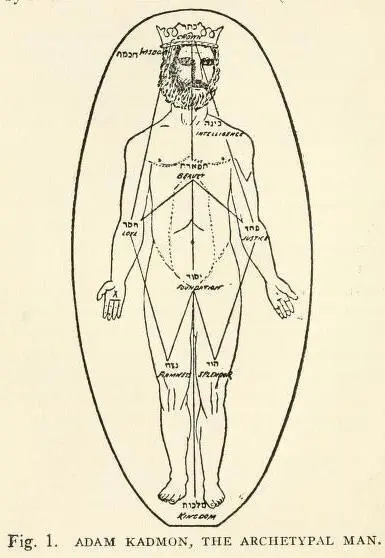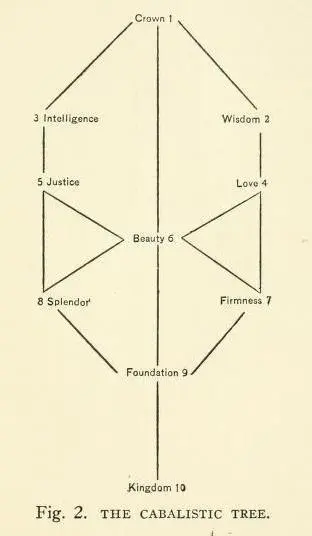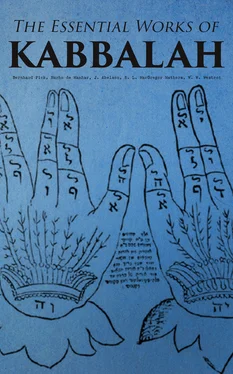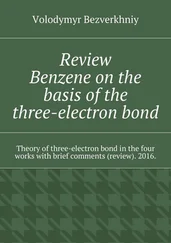1 ...8 9 10 12 13 14 ...42 The Cabalists delight in representing the ten Sephiroth under different forms; now as Adam Kadmon, "Primordial or Archetypal Man," now as the cabalistic tree or the Ilan, in which the crown is represented by the first Sephirah and the root by the last.
The Divine Man.-—As to the Adam Kadmon which is shown in the following figure, the Crown represents the head; Wisdom, the brains; Intelligence which unites the two and produces the first triad, the heart or the understanding. The fourth and fifth Sephiroth, i. e., Love and Justice are the two arms, the former the right arm and the latter the left; one distributing life and the other death. The sixth Sephirah, Beauty, uniting these two opposites and producing the second triad, is the chest. Firmness and Splendor of the third triad represent the two legs, whereas Foundation, the ninth Sephirah, represents the genital organs, since it denotes the basis and source of all things. Finally Kingdom, the tenth Sephirah, represents the harmony of the whole Archetypal Man.
Now in looking at the Sephiroth which constitute the first triad, it will be seen that they represent the intellect; hence this triad is called by Azariel the ''intellectual world" (olam muskal or olam ha-sechel). The second triad which represents moral qualities, is called the "moral" or "sensuous world" (olam murgash, also olam hanephesh) ; and the third, representing power and Stability, is called the "material world" (olam mutba or olam ha-teba).

Fig. 1. ADAM KADMON, THE ARCHETYPAL MAN.

Fig. 2. THE CABALISTIC TREE.

Fig. 3. THE PILLAR ARRANGEMENT.
As concerns the cabalistic tree (the ildn ha-cabala), the Sephiroth are so arranged that the first triad is placed above, the second and third are placed below, in such a manner that the three masculine Sephiroth are on the right, the three feminine on the left, whilst the four uniting Sephiroth occupy the center, as shown in Fig 2.
According to another arrangement the Sephiroth are so ordered that they form three pillars, a right one (sitra dimina, also amuda de-chesed, i. e., the pillar of mercy) ; a left one (sitra dismola, also amuda de-dina, i. e., the pillar of judgment), and a middle one (amuda de-emza'ita). In the right pillar to which belong the Sephiroth Wisdom, Love and Firmness, is life; in the left with the Sephiroth Intelligence, Judgment, Splendor, is Death. The middle pillar comprises Crown, Beauty, Foundation. The basis of all three pillars is the Kingdom. Fig. 3 illustrates this.
So far as the Sephiroth represent the first manifestation of God they form a world for themselves, an ideal world which has nothing to do with the real, material world. As such it is now called the primordial, the Archetypal Man (Adam Kadmon), now the Heavenly Man {Adam Hat). As for the Adam Kadmon, different views exist in the cabalistic writings. He is sometimes taken as the totality of the Sephiroth, and he appears as a pre-Sephirotic first emanation and superior to them, by which God manifested himself as creator and ruler of the world, as it were a prototype (macrocosm) of the entire creation. In this case it would seem as if the Adam Kadmon were a first manifestation, inserted between God and the world, so to say a second God or the divine Word.
According to a later theorem four worlds proceed by an emanation in different gradations. This is expressed by Ibn Latif thus: As the point extends and thickens into a line, the line into the plane, the plane into the expanded body, thus God's self-manifestation unfolds itself in the different worlds.
In each of these four worlds the ten Sephiroth recur. The first Sephirah gave birth to the Olam azila or "world of emanation," containing the powers of the divine plan of the world. Its beings have the same nature as that belonging to the world of the Sephiroth or to the Adam Kadmon. This world which is also called the olam ha-sephiroth, i. e., "the world of the Sephiroth," is the seat of the Shechinah. From the olam azila proceeded the olam beria or "world of creation," in which according to Rabbi Isaac Nasir 5are the souls of the saints, all the blessings, the throne of the Deity, and the palaces of all spiritual and moral perfection. The olam beria gave birth to the olam jezirah or "world of formation," in which dwell the holy angels, whose prince is Metatron. 6But there are also the demons, which on account of their grossly sensual nature are called Keliphoth, "shells," and inhabit the planets and other heavenly bodies or the realm of the ether.
The fourth world is called olam assiya, the "world of action." Its substances consist of matter limited by space and perceptible to the senses in a multiplicity of forms. It is subject to constant changes, generations, and corruptions, and is the abode of the Evil Spirit.
Like the Talmud and the Midrash, the Zohar represents the optimistic view, that the present world is the best. Thus we read (Zohar, III, 292b: "There were old worlds, which perished as soon as they came into existence; they were formless, and were called sparks. Thus the smith when hammering the iron, lets the sparks fly in all directions. These sparks are the primordial worlds, which could not continue, because the Sacred Aged had not as yet assumed his form (of opposite sexes—the King and Queen), and the Master was not yet at his work." And again we read (III, 61&) : "The Holy One, blessed be he, created and destroyed several worlds before the present one was made, and when this last work was nigh completed, all the things of this world, all the creatures of the universe, in whatever age they were to exist, before they entered into this world, were present before God in their true form. Thus are the words of Ecclesiastes to be understood. 'The thing that hath been, it is that which shall be; and that which is done is that which shall be done.' "
Since the Cabalists viewed all things from the anthropological point of view, they also transformed to the world of the Sephiroth the difference of sex. The male principle, called Abba, is white and of an active nature, appearing especially in the Sephirah Love, but also at the bottom of the three Sephiroth on the right side. The female principle, on the other hand, which owes its origin to the male principle, is red and of a receptive nature. It is mainly visible in the Sephira Justice, but is also at the bottom of the three Sephiroth on the left. The sign of the male principle is the "Y," that of the female the "H" in the divine name YHVH. What we learn is this: the Sephiroth teach that everything which exists is imperishable and like God. As nothing perishes in the world or is fully annihilated, thus the stamp and seal of divinity is stamped on all beings. God as the Invisible and Endless (En Soph) became visible and intelligible by the Sephiroth; the human mind can come to him, can know and conceive him.
The Realm of Evil.—Besides the heavenly realm of the Sephiroth of light or of the good, there is also a realm of the Sephiroth of darkness or of evil. Over against the supreme emanation of light, the Adam Kadmon, stands as opponent the Adam Belial. The same is the case with every light-sephirah, it is opposed by a Sephirah of darkness. Thus both are related to one another as the right side to the left; the lightSephiroth form the right side, the darknessSephiroth the left side (sitra achra). The realm of darkness is figuratively called also the kingdom of Cain, Esau and Pharaoh (Zohar, I, 55a). Like the kingdom of light that of darkness has ten degrees. As the kingdom of light is inhabited by good spirits, so the kingdom of darkness is inhabited by evil spirits (demons, shells). Their prince is called Samael (angel of poison or of death); his wife is called the Harlot or the Woman of Whoredom. Both are thought of as having intercourse with each other just as in the realm of light God as king has intercourse with Malchuth as queen. Through the influence of the evil powers the creation is continually disturbed. Men are seduced to apostasy from God, and thus the kingdom of the evil grows and the Keliphoth or shells increase. In the figurative language of the Zohar this disturbance of the creation is described as if the king and queen kept aloof from each other and could not work together for the welfare of the world. But this discord is finally harmonized by repentance, selfmortification, prayer and strict observance of the prescribed ceremonies, and the original harmony of things is again restored. It must be observed however that the teaching about the opposition of the two kingdoms belongs to the later doctrines of the Cabala and its development belongs to the thirteenth century.
Читать дальше















